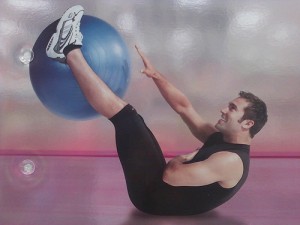by Michelle Sutton-Kerchner
Weight loss efforts usually invoke images of cardio sweat sessions. True, cardio workouts kick pounds to the curb. But, while you’re there, have a seat and grab some free weights …
Weightlifting is sometimes misunderstood. Traditionally, it was a workout for athletes and teenage boys wishing to “bulk up.” As a sport, it was associated with an elite group of super strong, ready to lift a car off the road single-handedly, just for fun. Weights and weight machines are getting their own workout these days as people recognize their additional uses. One major use: Weight loss.

As you get ready for summertime, and those summer clothes, get into shape and burn calories with weights. You will experience some unique results, including more efficient caloric burn. Don’t forget weightlifting’s ability to improve bone density and, most recently investigated, its potential to lower blood pressure.
Concentrate on Building Muscle
Muscles burn more calories than fat. Even during inactivity, muscles are busy boosting metabolism. Make TV time a little less guilt-ridden with toned muscles that continue working post-exercise, even when the only things in action are your taste buds as you crunch away on snacks.
Building and maintaining muscle mass helps burn calories more efficiently. Those with larger muscle mass burn more calories, even at rest. Ward off muscle loss common to aging by incorporating activities like weightlifting into your routine. This helps you look, and stay, fit. The aerobic portion of your fitness regimen helps burn calories in the short-term. Strength training builds muscles that help burn fat over the long-term.
Zealous weightlifters have been known to spike their resting metabolic rate for a brief interval beyond their workouts. This is a result of high exercise energy expenditure and high energy intake. Simply put: It’s the outcome of intense weightlifting, not just throwing around some dumbbells. Ironically, these endurance-trained athletes usually aren’t concerned with increasing their metabolism for weight-loss. And, the recreational exerciser typically doesn’t exercise at the intensity and length required for this short-lived metabolic perk.
Talk with a Personal Trainer

To the unfamiliar, the Exercise Floor may seem daunting. One wrong move, and you risk setting yourself up for discomfort or injury. There also is a risk of embarrassment, a worse fate for the self-conscious (and who isn’t). Plus, you may establish bad habits, such as incorrect form or misuse of equipment.
Before you begin, schedule your complimentary appointment with a personal trainer. Learn correctly as a beginner rather than having to unlearn later, when results lag and your body aches. Don’t hesitate to ask a trainer for assurance. A question or demo usually can be handled quickly. Take time now to be more efficient later. At the Center, personal trainers always are available to help.
Be Aware
You may have been an all-star athlete in college. That does not make you a weightlifting pro today. Take note of your current physical condition, easily done through your routine nurse evaluation at the Center. Determine if those heavy weights are still appropriate for you. If you’ve been away from strength training for a while, go back to the basics and use lighter weights.
If you’re new to strengthening, you may wish to practice using correct form without weights. You also can add body-weight exercises to your routine. Resistance train without free weights or machines. For example, perform three sets of squats, 10 reps each. Once this becomes easy, add five-pound dumbbells to each hand. Experts advise using weights that tire muscles after 10 repetitions. Anything heavier could cause a strain.
Consider your attitude at the approach of a workout. Although we would love to think our sunniest disposition overcomes us at the Center, there are days when even Boot Camp Boxing can’t energize or relieve stress. Be cautious during these times. Unlike a fitness class where you simply can walk the moves on a bad day, lifting weights takes what it takes.
With weights and weight machines, modifying your workout midway is not as easily done. Equipment is involved. You need to stop and reorganize, or cut the workout in half without having time to tackle all areas. To avoid inconvenience, we tend to push ahead. Imagine strength training while extremely fatigued or distracted by an angry mood. The latter can add power to your routine, but maybe a little too much.
Be mindful of your mental and physical state, and start your workout appropriately. Have a back-up routine ready for days when you cannot fully commit to your regular strength training.
Move Appropriately
Avoid overcompensating. Beginners are especially prone to moving the body to meet the weights. The weights should travel a straight line to meet the body. Be sure muscles targeted in a specific exercise are the ones feeling the burn. If other areas are feeling it, your form is probably incorrect. Also, make sure it is a healthy burn and not downright painful.

Always engage your core during strength training. By training your core, support radiates from that area to other muscles. When the core is neglected, other areas must compensate, especially the back and neck. Tighten your core as you strength train. Tense those muscles so they feel solid to the touch. Think support, support, support with each rep!
Try to advance your routine a little every week. As you grow comfortable, increase repetitions of the same exercise with the same weight. After that increase becomes comfortable, add to your weights or increase the machine’s challenge level. Don’ be afraid to go appropriately heavy when your body is ready. Heavier lifting builds lean, fat-burning muscles. As long as you can remain in proper form, go for it. (And, don’t worry about hulk-bulk from strength training. An appropriate weightlifting program builds muscles the way you work them.)
Increase your lifting tempo as another way to intensify your weight routine. Decrease your rest interval by 30 seconds. The goal: Spend added time with muscles flexed to tone them and burn more fat.
Try to alternate the muscle groups you target so the same area does not get worked two consecutive days. Allow rest days, especially after a full-body workout. Aim for three days of weight training and two days of cardio work each week. You can even alternate that schedule to keep your body guessing and your mind engaged.
After about six weeks of strength training on a regular basis, it is time for a new program. Introduce new weights, machines, rep counts, and weight amounts. A new adventure keeps things exciting and fitness progress possible.
Consistency Is Key
Minor post-workout soreness is expected. However, do not excessively strain during strength training. This leads to a degree of soreness that interferes with your program. A day of rest is appropriate. Aches that lead to a week of rest are not, especially when accompanied by the mistaken thought that pain means you tackled enough exercise for a week.
 Muscles need to be consistently challenged to gain results. Monitor your form and exhaustion level throughout strength training. If muscles begin to react by shaking from the strain, it is time to cool down. Know when your body has done enough. A trainer is especially helpful at determining the fine line between pushing yourself and going too far. Ask for insight!
Muscles need to be consistently challenged to gain results. Monitor your form and exhaustion level throughout strength training. If muscles begin to react by shaking from the strain, it is time to cool down. Know when your body has done enough. A trainer is especially helpful at determining the fine line between pushing yourself and going too far. Ask for insight!
Strength training is not a race. It takes time to establish which exercises improve personal weaknesses and enhance strengths. Create routines that engage your mind enough to keep you interested and your body enough to get results. Then, build upon them, one rep at a time.
Sources
“Does Exercise Affect Resting Metabolism?” by Elizabeth Quinn at www.about.com.
“4 Big Weight-Lifting Mistakes (and How to Fix Them!) by Cory Stieg at www.womenshealthmag.com.
“7 Tips for Weight-Lifting Newbies,” by Casey Gueren at www.abcnews.com.
Image Credits
Weightlifting baby boomer: www.flickr.com/photos/36662144@N05/10291333283/
Summer clothes: https://www.flickr.com/photos/59425732@N03/5958205113/
Exercise with ball: www.flickr.com/photos/chrisdlugosz/3516053286/
Weights: www.flickr.com/photos/ericmcgregor/346990046
 Fitness & Wellness News Your Source for Fitness News, Wellness News, Health News, and Nutrition News!
Fitness & Wellness News Your Source for Fitness News, Wellness News, Health News, and Nutrition News!




